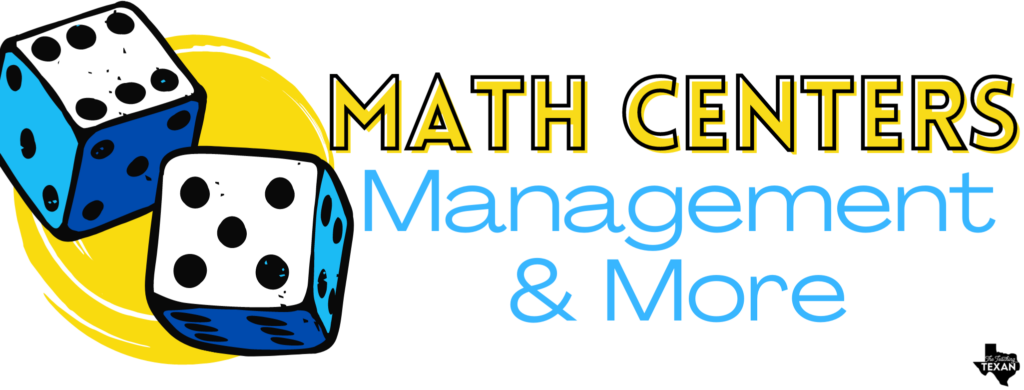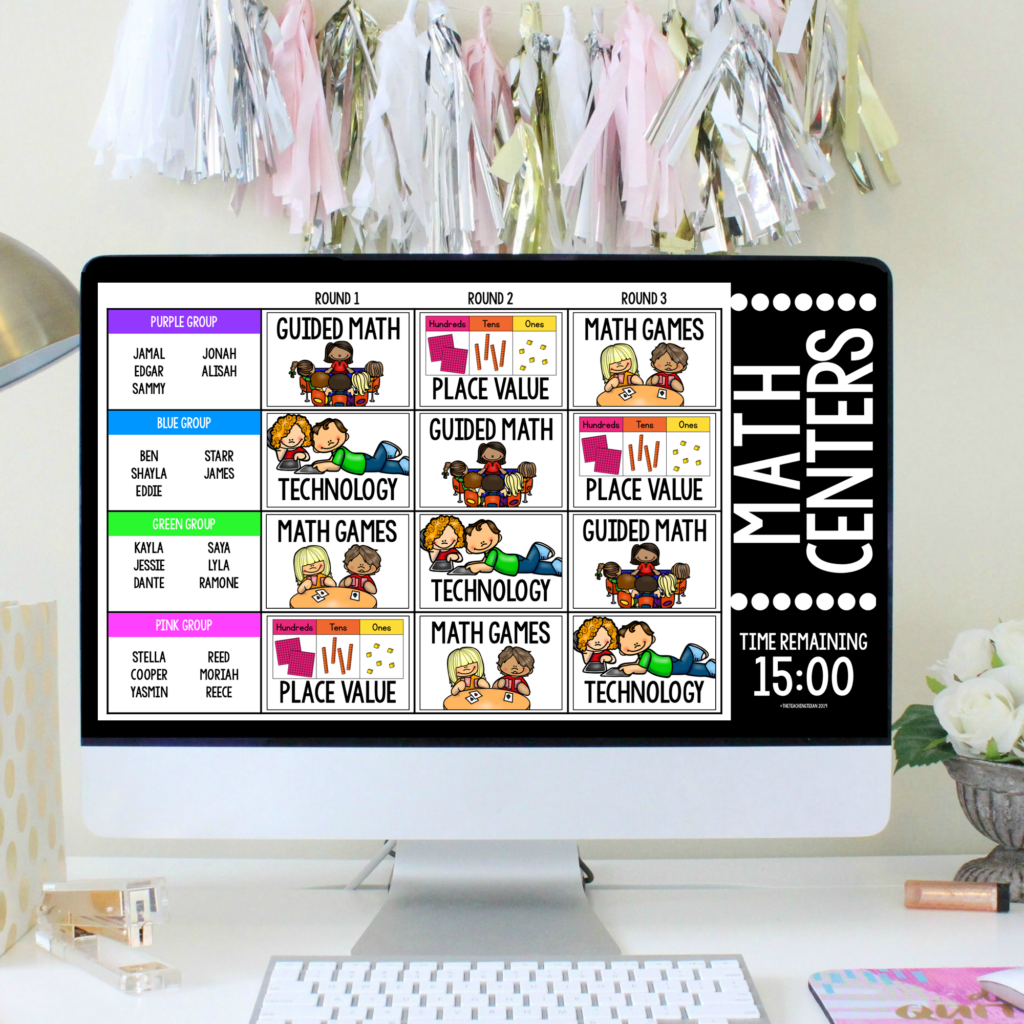How to: Math Centers and Management
Imagine with me. It’s transition time. Your math block is well under way. You’ve engaged students in a quick warm-up to gently get the left sides of their brains moving. They’re (finally!) excited about math. You’re just wrapping up the day’s group lesson and moving towards math centers. It’s critical, this moment. This time between one activity and the next.
In my classroom, math centers occur after a 15-20 minute group lesson. In that lesson I’ll introduce new skills and give students a chance to practice them together. Then, we jump straight into math centers, shifting gears. The goals are completely different in centers than in our group lesson.
Together, we learned and explored new skills. In small groups at their centers, the student’s time is better spent practicing skills they already know, working together with others at their table, and strengthening their independence. Plus, centers allow time for guided math lessons. I can work with one on one or in small groups with students who are struggling to strengthen the new skills we’re learning or the ones’ in need of some behavior management (try as we might, we all have them).

Today we’re tackling how you can plan for success in these centers so…
- Students can use their time wisely.
- You can manage the classroom while simultaneously providing 1-to-1 instruction in small groups.
No one said teaching was easy y’all, but luckily, I’ve already solved this problem 😝😝 (see what I did there?)
It’s All in the Timing
Let’s start here. I’m always getting questions about how long each center should be. And the honest answer is, it depends. Having taught at multiple elementary levels throughout my career, I’ve found it depends on three things:
- Your school schedule
- The level of your students
- Students’ age
In Kindergarten 10-12 minutes might be just perfect, in First Grade you can stretch that a little more to 15 to 20 minutes, and Second Grade 20 minutes or more can be doable. You can also split your centers into 2 days if you need to – students complete half day 1 and the second half day 2 – get creative!
Of course if you’re looking for fun ways to incorporate digital practice, you know I’ve got you covered there too!
Plan for Self-Management
Remember, we’re looking to create a space where students can be completely independent, managing themselves, and engaging in meaningful educational activities on their own so you’re free to work with small groups. Set yourself up for success by considering the following when planning.
Automaticity and Pre-Taught Skills
What skills do my students already know but need time to practice for automaticity? Math centers are not the time to introduce something new! It’s a perfect time, however, to give students an opportunity to practice previously taught skills that need cementing in their brain. For example, yes your kindergarteners might know how to add and subtract, but if they’re still counting on their fingers instead of automatically calculating in their head, this is a perfect skill to work on during math centers. Or your second graders mastering multiplication? Perhaps they need a fun way to practice those skills! They don’t need to ask you anything, can work independently, AND get valuable practice time on important life skills.
Differentiation
Where is there room for differentiating within a center so students can work on multiple levels simultaneously in a group? When you group students, considering their different skill levels is a great way to mix and match your classroom. However, it might not be productive for students of different levels to be working on the exact same activity. When planning centers, consider differentiated activities (or activities you can easily add differentiated options to) so students have the opportunity to challenge themselves instead of getting bored. Check these out to make your math center off the chart!
Time Management
We don’t just teach how to tell time in math, we’re also giving our students a concrete way to practice time management. Two concrete ways to do this (while simultaneously promoting independence!) are…
- Gather the materials for each center into some form of bin so students have everything they need at their fingertips. This may take a little more prep time, but I promise you, it saves a tremendous amount of instructional time.
- Display a road map for your center time so students know what they are doing currently, what’s coming next, and how much time they have. Don’t know how this would look? I’ve created easy-to-use center slides complete with timers to cut down on your planning time 😉
Keeping the above in mind when planning is oh so important. But also make sure to keep track of what skills you’ve been practicing so you can track student progress. My guided math binder printable resource has a tracking page that helps you easily keep track of each student. Plus, if you’re keeping track along the way, you’ll know when students fall behind and be able to intervene and catch them up as necessary. I’ve also got a no-prep Math Intervention resource for kiddos that struggle.

More Planning Tips
Looking for specific center activities to engage your students? Below are some of my absolute favorites — and my kiddos LOVE them too!
- GAMES! This is the heart and soul of our math center time! We know that kids learn best when they are engaged and having fun. Some class favorites include:
- Kindergarten
- First Grade
- Second Grade
- Addition/Subtraction Bowling — using mini-bowling pins (or even just markers at the end of a table with a small rubber ball), students “bowl” and record their score by subtracting from 10. To differentiate, have students include the subtraction AND addition facts side-by-side.
- Glyphs! Who doesn’t love a little art that created a child-centered display mixed with graphing, data, and more?!
- Jack O’Lantern Glyph
- Turkey Glyph
- Gingerbread Glyph
- Penguin Glyph
- Digital Practice! We are relying on technology more than ever, and here are some of my favorite tech resources.
- First Grade Digital Math Practice
- ABCya! has some of the BEST **free** games for practicing all sorts of math concepts.
- Printable Curriculum Materials: Does your curriculum include printed materials for students to complete? That can make a great center without having to take up too much instructional time while still checking things off that curriculum list!
- Coding: It’s 2020 and kids need to learn coding. Full stop. There are a million wonderful free resources
(that are also yes, you guessed it, GAMES!) for students to start building foundational coding skills. I recommend Kodable, ScratchJr, Osmo, Coding Safari, or Box Island, among others. - Unfinished Work Folder: Don’t forget that you can build in time for students who need extra time to complete assignments! And for those kiddos who always finish early, assigning some digital activities that require no prep for them to independently complete as needed is always a winner.
- Guided Math: This center deserves a post all it’s own so we’ll tackle it in the next post, but suffice it to say that one of the main goals of all these centers is to create space and time for you to work with small groups or individual students for guided math. It’s just as important as guided reading!!! (uh oh, have I said that already a HUNDRED TIMES?!?! It’s that important y’all!)

And don’t forget, if you’re new to math centers or trying to figure out a way to work in some guided math for the first time, allow yourself some time to learn the ropes. You’ll get things wrong, try again and eventually come up with a solution that works both for you and your kiddos. Rome wasn’t built in a day, and neither were math centers! Take that first step, then another, and another until you’ve built a system that works for YOU and YOUR students.

